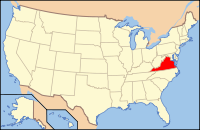Stafford County, Virginia
| Stafford County, Virginia | |
|---|---|

The Stafford County Courthouse in October 2013.
|
|
 Location in the U.S. state of Virginia |
|
 Virginia's location in the U.S. |
|
| Founded | 1664 |
| Named for | Staffordshire, England |
| Seat | Stafford |
| Largest community | Aquia Harbor |
| Area | |
| • Total | 280 sq mi (725 km2) |
| • Land | 269 sq mi (697 km2) |
| • Water | 11 sq mi (28 km2), 3.9% |
| Population (est.) | |
| • (2015) | 142,003 |
| • Density | 507/sq mi (196/km²) |
| Congressional district | 1st |
| Time zone | Eastern: UTC-5/-4 |
| Website | staffordcountyva |
Stafford County is a county located in the Commonwealth of Virginia. As of the 2010 census, the population was 128,961. Its county seat is Stafford.
Located across the Rappahannock River from the City of Fredericksburg, Stafford County is part of the Washington-Arlington-Alexandria, DC-VA-MD-WV Metropolitan Statistical Area. In 2006, and again in 2009, Stafford was ranked as the 11th highest income county in America by Forbes magazine.
For thousands of years, various cultures of indigenous peoples succeeded each other in their territories along the Potomac River and its tributaries. By the time of English colonization, there were 32 Algonquian-speaking American Indian tribes in the present-day coastal Tidewater Virginia area, including those of the Patawomeck and numerous tribes that were part of the Powhatan Confederacy. The former small tribe, still centered in Stafford County, was recognized by the state of Virginia in 2010.
The Native Americans' first recorded encounter with Europeans in this area was in 1608, with John Smith of the Jamestown Settlement. During a time of recurring tension between the early English colonists and local Native Americans, the colonists led by Samuel Argall captured Chief Powhatan's daughter, Pocahontas while she was residing with her husband, Kocoum. It occurred in the eastern part of this county, from where they took her to a secondary English settlement, known as Henricus (or Henrico Town). Alexander Whitaker converted Pocahontas to Christianity during her captivity. He renamed the princess "Rebecca" at her baptism. Rebecca married English colonist John Rolfe on April 5, 1614 in Jamestown.
...
Wikipedia
